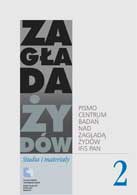Menu
- Main Page
- About us
- Research
- Publications
- Links
- Contact
- Archiwum
- Holocaust. Studies and Materials
the Center's Journal - NIGHT WITHOUT AND END - »FAILED CORRECTION«
- Wybór źródeł
- EHRI PL
News
Programme of Center's academic seminars for winter term 2025
We are pleased to announce the return of our scientific seminar series in less than a month, and warmly invite all interested parties to attend. The seminars will be held on the second or third Wednesday of each month, both in person at the Institute of Philosophy and Sociology of the Polis...
M. Turski Historical Award of Polityka for Justyna Majewska
It is with undisguised pride we report that our colleague Dr. Justyna Majewska has been awarded the Marian Turski POLITYKA Historical Prize for her book debut, "Mury i szczeliny. Przestrzenie getta warszawskiego /Walls and Slits. Spaces of the Warsaw Ghetto". We are very happy and...
Call for Articles - Holocaust Studies and Materials 2026
Call for Articles 2026 Call for Articles Connecting scholarly reflection on the Holocaust to the present - new sources and technologies in research The past decade has seen a breakthrough in Holocaust research, both in terms of the availability of archival sources and the digital ...
Farewell to Marian Turski
It is with profound sorrow that we bid farewell to Marian Turski—a distinguished journalist, historian, and Survivor. An extraordinary man whose voice resonated deeply, he not only shared the lessons of the past but actively championed courage, solidarity, and empathy in the face of evil. ...
Center in EHRI PL consortium
Polish Center for Holocaust Research of the Institute of Philosophy and Sociology of the Polish Academy of Sciences, together with the E. Ringelblum Jewish Historical Institute and the Center for Jewish Studies of the University of Lodz, are creating a national node of the European Holocaust Research Infrastructure within the framework of ERIC
NEWSLETTER
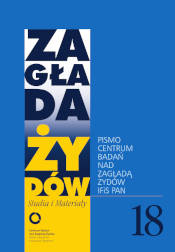 Zagłada Żydów.
Zagłada Żydów.
Studia i Materiały
nr 18, R. 2022
Warszawa 2022
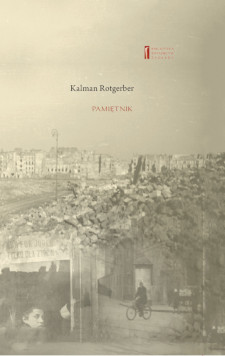 PAMIĘTNIK
PAMIĘTNIK
Kalman Rotgeber
oprac. Aleksandra Bańkowska, wstęp Jacek Leociak
Warszawa 2021
Zagłada Żydów.
Studia i Materiały
nr 17, R. 2021
Warszawa 2021
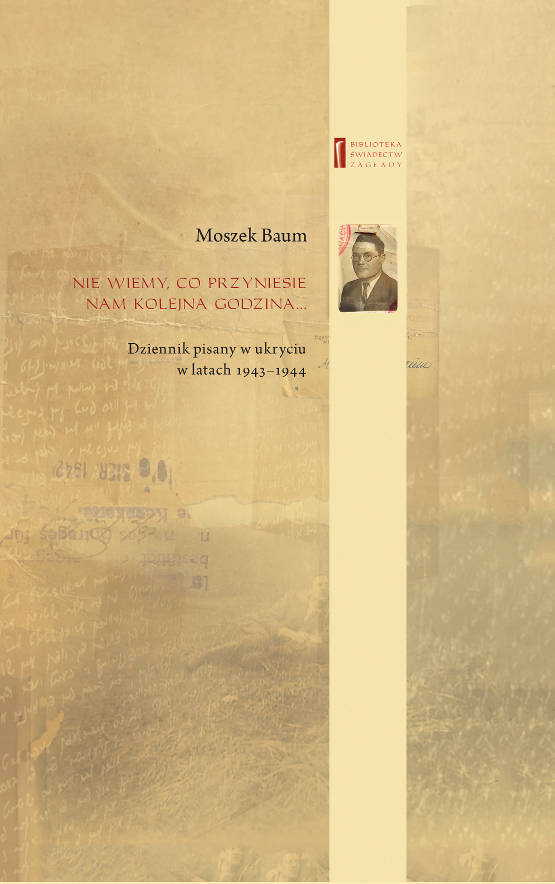 NIE WIEMY CO PRZYNIESIE NAM KOLEJNA GODZINA ...
NIE WIEMY CO PRZYNIESIE NAM KOLEJNA GODZINA ...
Dziennik pisany w ukryciu w latach 1943-1944
Moszek Baum, oprac. Barbara Engelking, tłum. z jidysz Monika Polit
Warszawa 2020
Zagłada Żydów.
Studia i Materiały
nr 16, R. 2020
Warszawa 2020
.jpg) Aryjskiego Żyda wspomnienia, łzy i myśli
Aryjskiego Żyda wspomnienia, łzy i myśli
Zapiski z okupacyjnej Warszawy
Sewek Okonowski, oprac. Marta Janczewska
 PISZĄCY TE SŁOWA JEST PRACOWNIKIEM
PISZĄCY TE SŁOWA JEST PRACOWNIKIEM
GETTOWEJ INSTYTUCJI ...
'z Dziennika' i inne pisma z łódzkiego getta
Józef Zelkowicz, tłum. z jidysz, oprac. i wstęp. Monika Polit
Warszawa 2019
CZYTAJĄC GAZETĘ NIEMIECKĄ ...
Dziennik pisany w ukryciu w Warszawie w latach 1943-1944
Jakub Hochberg, oprac. i wstępem opatrzyła Barbara Engelking
Warszawa 2019
Zagłada Żydów.
Studia i Materiały
nr 15, R. 2019
Warszawa 2019
.jpg) Zagłada Żydów.
Zagłada Żydów.
Studia i Materiały
nr 14, R. 2018
Warszawa 2018
 DALEJ JEST NOC. Losy Żydów w wybranych powiatach okupowanej Polski
DALEJ JEST NOC. Losy Żydów w wybranych powiatach okupowanej Polski
red. i wstęp Barbara Engelking, Jan Grabowski
Warszawa 2018
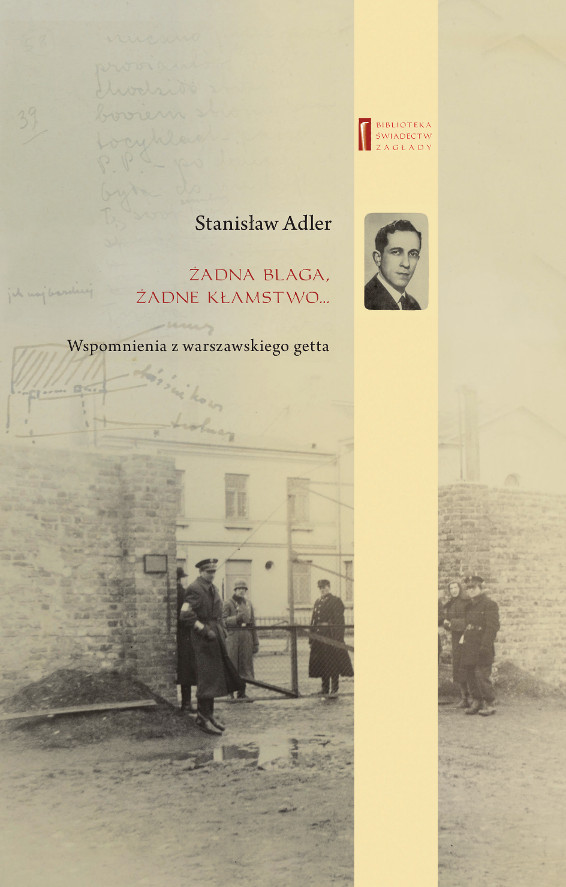 ŻADNA BLAGA, ŻADNE KŁAMSTWO ...
ŻADNA BLAGA, ŻADNE KŁAMSTWO ...
Wspomnienia z warszawskiego getta
Stanisław Adler, oprac. i wstępem opatrzyła Marta Janczewska
Warszawa 2018
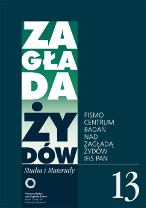 Zagłada Żydów.
Zagłada Żydów.
Studia i Materiały
nr 13, R. 2017
Warszawa 2017
 TYLEŚMY JUŻ PRZESZLI ...
TYLEŚMY JUŻ PRZESZLI ...
Dziennik pisany w bunkrze (Żółkiew 1942-1944)
Clara Kramer, oprac. i wstępem opatrzyła Anna Wylegała
Warszawa 2017
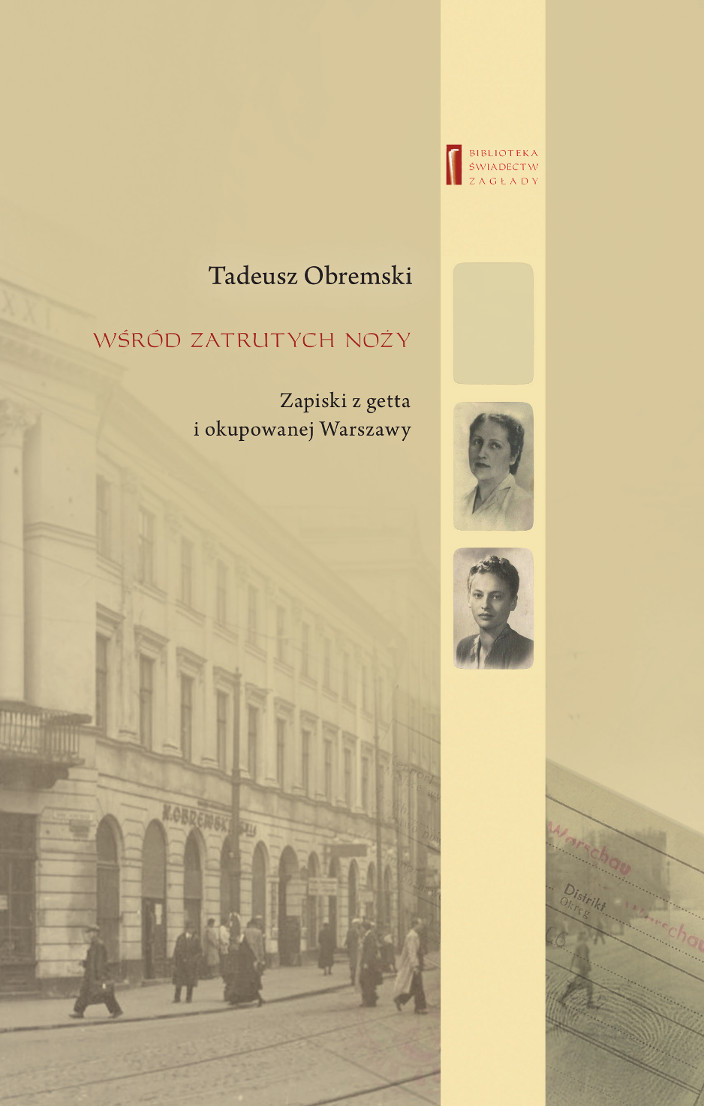 WŚRÓD ZATRUTYCH NOŻY ...
WŚRÓD ZATRUTYCH NOŻY ...
Zapiski z getta i okupowanej Warszawy
Tadeusz Obremski, oprac. i wstępem opatrzyła Agnieszka Haska
Warszawa 2017
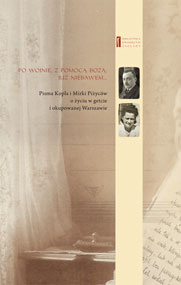 PO WOJNIE, Z POMOCĄ BOŻĄ, JUŻ NIEBAWEM ...
PO WOJNIE, Z POMOCĄ BOŻĄ, JUŻ NIEBAWEM ...
Pisma Kopla i Mirki Piżyców o życiu w getcie i okupowanej Warszawie
oprac. i wstępem opatrzyła Barbara Engelking i Havi Dreifuss
Warszawa 2017
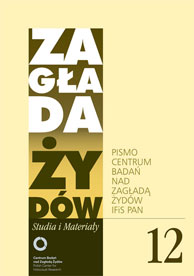 Zagłada Żydów.
Zagłada Żydów.
Studia i Materiały
nr 12, R. 2016
Warszawa 2016
.jpg) SNY CHOCIAŻ MAMY WSPANIAŁE ...
SNY CHOCIAŻ MAMY WSPANIAŁE ...
Okupacyjne dzienniki Żydów z okolic Mińska Mazowieckiego
oprac. i wstępem opatrzyła Barbara Engelking
Warszawa 2016
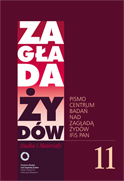 Zagłada Żydów.
Zagłada Żydów.
Studia i Materiały
nr 11, R. 2015
Warszawa 2015
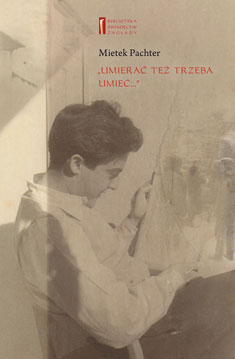 Mietek Pachter
Mietek Pachter
UMIERAĆ TEŻ TRZEBA UMIEĆ ...
oprac. B. Engelking
Warszawa 2015
 Zagłada Żydów.
Zagłada Żydów.
Studia i Materiały
nr 10, t. I-II, R. 2014
Warszawa 2015
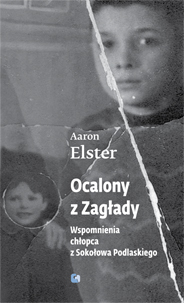 OCALONY Z ZAGŁADY
OCALONY Z ZAGŁADY
Wspomnienia chłopca z Sokołowa Podlaskiego
tłum. Elżbieta Olender-Dmowska
red .B. Engelking i J. Grabowski
Warszawa 2014
 ZAGŁADA ŻYDÓW. STUDIA I MATERIAŁY
ZAGŁADA ŻYDÓW. STUDIA I MATERIAŁY
vol. 9 R. 2013
Pismo Centrum Badań nad Zagładą Żydów IFiS PAN
Warszawa 2013
 ... TĘSKNOTA NACHODZI NAS JAK CIĘŻKA CHOROBA ...
... TĘSKNOTA NACHODZI NAS JAK CIĘŻKA CHOROBA ...
Korespondencja wojenna rodziny Finkelsztejnów, 1939-1941
oprac. i wstępem opatrzyła Ewa Koźmińska-Frejlak
Warszawa 2012
Raul Hilberg
PAMIĘĆ I POLITYKA. Droga historyka Zagłady
tłum. Jerzy Giebułtowski
Warszawa 2012
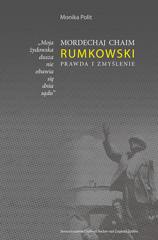 Monika Polit
Monika Polit
"Moja żydowska dusza nie obawia się dnia sądu."
Mordechaj Chaim Rumkowski. Prawda i zmyślenie
Warszawa 2012
.jpg) Dariusz Libionka i Laurence Weinbaum
Dariusz Libionka i Laurence Weinbaum
Bohaterowie, hochsztaplerzy, opisywacze. Wokół Żydowskiego Związku Wojskowego
Warszawa 2011
.jpg) Zagłada Żydów.
Zagłada Żydów.
Studia i Materiały
R. 2011, nr. 7; Warszawa 2011
.jpg) Jan Grabowski
Jan Grabowski
JUDENJAGD. Polowanie na Żydów 1942.1945.
Studium dziejów pewnego powiatu
Warszawa 2011
.jpg) Stanisław Gombiński (Jan Mawult)
Stanisław Gombiński (Jan Mawult)
Wspomnienia policjanta z warszawskiego getta
oprac. i wstęp Marta Janczewska
Warszawa 2010
Holocaust Studies and Materials
Journal of the Polish Center for Holocaust Research
Warssaw 2010
.jpg) Żydów łamiących prawo należy karać śmiercią!
Żydów łamiących prawo należy karać śmiercią!
"Przestępczość" Żydów w Warszawie, 1939-1942
B. Engelking, J. Grabowski
Warszawa 2010
Zagłada Żydów.
Studia i Materiały
R. 2010, nr. 6; Warszawa 2010
Wybór źródeł do nauczania o zagładzie Żydów
Ćwiczenia ze źródłami
red. A. Skibińska, R. Szuchta
Warszawa 2010
.jpg) W Imię Boże!
W Imię Boże!
Cecylia Gruft
oprac. i wstęp Łukasz Biedka
Warszawa 2009
Zagłada Żydów.
Studia i Materiały
R. 2009, nr. 5; Warszawa 2009
.jpg) Żydzi w powstańczej Warszawie
Żydzi w powstańczej Warszawie
Barbara Engelking i Dariusz Libionka
Warszawa 2009
 Reportaże z warszawskiego getta
Reportaże z warszawskiego getta
Perec Opoczyński
Warszawa 2009
 Notatnik
Notatnik
Szmul Rozensztajn
Warszawa 2008
.jpg) Holocaust
Holocaust
Studies and Materials.
English edition
2008, vol. 1; Warsaw 2008
.jpg) Źródła do badań nad zagładą Żydów na okupowanych ziemiach polskich
Źródła do badań nad zagładą Żydów na okupowanych ziemiach polskich
Przewodnik archiwalno-bibliograficzny
Alina Skibińska, wsp. Marta Janczewska, Dariusz Libionka, Witold Mędykowski, Jacek Andrzej Młynarczyk, Jakub Petelewicz, Monika Polit
Warszawa 2007
Zagłada Żydów. Studia i Materiały
R. 2007, nr. 3; Warszawa 2007
Prowincja noc.
Życie i zagłada Żydów w dystrykcie warszawskim
Warszawa 2007
.jpg) Utajone miasto.
Utajone miasto.
Żydzi po 'aryjskiej' stronie Warszawy [1941-1944]
Gunnar S Paulsson
Kraków 2007
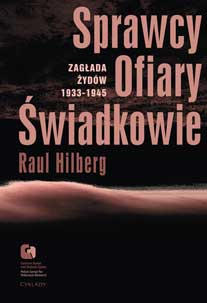 Sprawcy, Ofiary, Świadkowie.
Sprawcy, Ofiary, Świadkowie.
Zagłada Żydów, 1933-1944
Raul Hilberg
Warszawa 2007
Zagłada Żydów. Studia i Materiały
R. 2006, nr. 2; Warszawa 2006
"Jestem Żydem, chcę wejść!".
Hotel Polski w Warszawie, 1943.
Agnieszka Haska
Warszawa 2006
Zagłada Żydów. Studia i Materiały
R. 2005, nr. 1; Warszawa 2005
.jpg) 'Ja tego Żyda znam!'
'Ja tego Żyda znam!'
Szantażowanie Żydów w Warszawie, 1939-1943.
Jan Grabowski
Warszawa 2004
 'Szanowny panie Gistapo!'
'Szanowny panie Gistapo!'
Donosy do władz niemieckich w Warszawie i okolichach, 1940-1941
Barbara Engelking, Warszawa 2003
aaa
 Zagłada Żydów.
Zagłada Żydów.
Studia i Materiały
nr 18, R. 2022
Warszawa 2022
 PAMIĘTNIK
PAMIĘTNIK
Kalman Rotgeber
oprac. Aleksandra Bańkowska, wstęp Jacek Leociak
Warszawa 2021
Zagłada Żydów.
Studia i Materiały
nr 17, R. 2021
Warszawa 2021
 NIE WIEMY CO PRZYNIESIE NAM KOLEJNA GODZINA ...
NIE WIEMY CO PRZYNIESIE NAM KOLEJNA GODZINA ...
Dziennik pisany w ukryciu w latach 1943-1944
Moszek Baum, oprac. Barbara Engelking, tłum. z jidysz Monika Polit
Warszawa 2020
Zagłada Żydów.
Studia i Materiały
nr 16, R. 2020
Warszawa 2020
.jpg) Aryjskiego Żyda wspomnienia, łzy i myśli
Aryjskiego Żyda wspomnienia, łzy i myśli
Zapiski z okupacyjnej Warszawy
Sewek Okonowski, oprac. Marta Janczewska
 PISZĄCY TE SŁOWA JEST PRACOWNIKIEM
PISZĄCY TE SŁOWA JEST PRACOWNIKIEM
GETTOWEJ INSTYTUCJI ...
'z Dziennika' i inne pisma z łódzkiego getta
Józef Zelkowicz, tłum. z jidysz, oprac. i wstęp. Monika Polit
Warszawa 2019
CZYTAJĄC GAZETĘ NIEMIECKĄ ...
Dziennik pisany w ukryciu w Warszawie w latach 1943-1944
Jakub Hochberg, oprac. i wstępem opatrzyła Barbara Engelking
Warszawa 2019
Zagłada Żydów.
Studia i Materiały
nr 15, R. 2019
Warszawa 2019
.jpg) Zagłada Żydów.
Zagłada Żydów.
Studia i Materiały
nr 14, R. 2018
Warszawa 2018
 DALEJ JEST NOC. Losy Żydów w wybranych powiatach okupowanej Polski
DALEJ JEST NOC. Losy Żydów w wybranych powiatach okupowanej Polski
red. i wstęp Barbara Engelking, Jan Grabowski
Warszawa 2018
 ŻADNA BLAGA, ŻADNE KŁAMSTWO ...
ŻADNA BLAGA, ŻADNE KŁAMSTWO ...
Wspomnienia z warszawskiego getta
Stanisław Adler, oprac. i wstępem opatrzyła Marta Janczewska
Warszawa 2018
 Zagłada Żydów.
Zagłada Żydów.
Studia i Materiały
nr 13, R. 2017
Warszawa 2017
 TYLEŚMY JUŻ PRZESZLI ...
TYLEŚMY JUŻ PRZESZLI ...
Dziennik pisany w bunkrze (Żółkiew 1942-1944)
Clara Kramer, oprac. i wstępem opatrzyła Anna Wylegała
Warszawa 2017
 WŚRÓD ZATRUTYCH NOŻY ...
WŚRÓD ZATRUTYCH NOŻY ...
Zapiski z getta i okupowanej Warszawy
Tadeusz Obremski, oprac. i wstępem opatrzyła Agnieszka Haska
Warszawa 2017
 PO WOJNIE, Z POMOCĄ BOŻĄ, JUŻ NIEBAWEM ...
PO WOJNIE, Z POMOCĄ BOŻĄ, JUŻ NIEBAWEM ...
Pisma Kopla i Mirki Piżyców o życiu w getcie i okupowanej Warszawie
oprac. i wstępem opatrzyła Barbara Engelking i Havi Dreifuss
Warszawa 2017
 Zagłada Żydów.
Zagłada Żydów.
Studia i Materiały
nr 12, R. 2016
Warszawa 2016
.jpg) SNY CHOCIAŻ MAMY WSPANIAŁE ...
SNY CHOCIAŻ MAMY WSPANIAŁE ...
Okupacyjne dzienniki Żydów z okolic Mińska Mazowieckiego
oprac. i wstępem opatrzyła Barbara Engelking
Warszawa 2016
 Zagłada Żydów.
Zagłada Żydów.
Studia i Materiały
nr 11, R. 2015
Warszawa 2015
 Mietek Pachter
Mietek Pachter
UMIERAĆ TEŻ TRZEBA UMIEĆ ...
oprac. B. Engelking
Warszawa 2015
 Zagłada Żydów.
Zagłada Żydów.
Studia i Materiały
nr 10, t. I-II, R. 2014
Warszawa 2015
 OCALONY Z ZAGŁADY
OCALONY Z ZAGŁADY
Wspomnienia chłopca z Sokołowa Podlaskiego
tłum. Elżbieta Olender-Dmowska
red .B. Engelking i J. Grabowski
Warszawa 2014
 ZAGŁADA ŻYDÓW. STUDIA I MATERIAŁY
ZAGŁADA ŻYDÓW. STUDIA I MATERIAŁY
vol. 9 R. 2013
Pismo Centrum Badań nad Zagładą Żydów IFiS PAN
Warszawa 2013
 ... TĘSKNOTA NACHODZI NAS JAK CIĘŻKA CHOROBA ...
... TĘSKNOTA NACHODZI NAS JAK CIĘŻKA CHOROBA ...
Korespondencja wojenna rodziny Finkelsztejnów, 1939-1941
oprac. i wstępem opatrzyła Ewa Koźmińska-Frejlak
Warszawa 2012
Raul Hilberg
PAMIĘĆ I POLITYKA. Droga historyka Zagłady
tłum. Jerzy Giebułtowski
Warszawa 2012
 Monika Polit
Monika Polit
"Moja żydowska dusza nie obawia się dnia sądu."
Mordechaj Chaim Rumkowski. Prawda i zmyślenie
Warszawa 2012
.jpg) Dariusz Libionka i Laurence Weinbaum
Dariusz Libionka i Laurence Weinbaum
Bohaterowie, hochsztaplerzy, opisywacze. Wokół Żydowskiego Związku Wojskowego
Warszawa 2011
.jpg) Zagłada Żydów.
Zagłada Żydów.
Studia i Materiały
R. 2011, nr. 7; Warszawa 2011
.jpg) Jan Grabowski
Jan Grabowski
JUDENJAGD. Polowanie na Żydów 1942.1945.
Studium dziejów pewnego powiatu
Warszawa 2011
.jpg) Stanisław Gombiński (Jan Mawult)
Stanisław Gombiński (Jan Mawult)
Wspomnienia policjanta z warszawskiego getta
oprac. i wstęp Marta Janczewska
Warszawa 2010
Holocaust Studies and Materials
Journal of the Polish Center for Holocaust Research
Warssaw 2010
.jpg) Żydów łamiących prawo należy karać śmiercią!
Żydów łamiących prawo należy karać śmiercią!
"Przestępczość" Żydów w Warszawie, 1939-1942
B. Engelking, J. Grabowski
Warszawa 2010
Zagłada Żydów.
Studia i Materiały
R. 2010, nr. 6; Warszawa 2010
Wybór źródeł do nauczania o zagładzie Żydów
Ćwiczenia ze źródłami
red. A. Skibińska, R. Szuchta
Warszawa 2010
.jpg) W Imię Boże!
W Imię Boże!
Cecylia Gruft
oprac. i wstęp Łukasz Biedka
Warszawa 2009
Zagłada Żydów.
Studia i Materiały
R. 2009, nr. 5; Warszawa 2009
.jpg) Żydzi w powstańczej Warszawie
Żydzi w powstańczej Warszawie
Barbara Engelking i Dariusz Libionka
Warszawa 2009
 Reportaże z warszawskiego getta
Reportaże z warszawskiego getta
Perec Opoczyński
Warszawa 2009
 Notatnik
Notatnik
Szmul Rozensztajn
Warszawa 2008
.jpg) Holocaust
Holocaust
Studies and Materials.
English edition
2008, vol. 1; Warsaw 2008
.jpg) Źródła do badań nad zagładą Żydów na okupowanych ziemiach polskich
Źródła do badań nad zagładą Żydów na okupowanych ziemiach polskich
Przewodnik archiwalno-bibliograficzny
Alina Skibińska, wsp. Marta Janczewska, Dariusz Libionka, Witold Mędykowski, Jacek Andrzej Młynarczyk, Jakub Petelewicz, Monika Polit
Warszawa 2007
Zagłada Żydów. Studia i Materiały
R. 2007, nr. 3; Warszawa 2007
Prowincja noc.
Życie i zagłada Żydów w dystrykcie warszawskim
Warszawa 2007
.jpg) Utajone miasto.
Utajone miasto.
Żydzi po 'aryjskiej' stronie Warszawy [1941-1944]
Gunnar S Paulsson
Kraków 2007
 Sprawcy, Ofiary, Świadkowie.
Sprawcy, Ofiary, Świadkowie.
Zagłada Żydów, 1933-1944
Raul Hilberg
Warszawa 2007
Zagłada Żydów. Studia i Materiały
R. 2006, nr. 2; Warszawa 2006
"Jestem Żydem, chcę wejść!".
Hotel Polski w Warszawie, 1943.
Agnieszka Haska
Warszawa 2006
Zagłada Żydów. Studia i Materiały
R. 2005, nr. 1; Warszawa 2005
.jpg) 'Ja tego Żyda znam!'
'Ja tego Żyda znam!'
Szantażowanie Żydów w Warszawie, 1939-1943.
Jan Grabowski
Warszawa 2004
 'Szanowny panie Gistapo!'
'Szanowny panie Gistapo!'
Donosy do władz niemieckich w Warszawie i okolichach, 1940-1941
Barbara Engelking, Warszawa 2003
aaa
Nowy Swiat St. 72, 00-330 Warsaw; POLAND;
Palac Staszica room 120
e-mail: centrum@holocaustresearch.pl
NIGHT WITHOUT END - Failed correctiion - Tomasz Frydel
Tomasz Frydel see in PDF![]()
University of Toronto
centrum@holocaustresearch.pl
Response to the Review
by Tomasz Domański Entitled Correcting the Picture? Reflections on the Sources Used in "Night Without an End. Fate of Jews in Selected Counties of Occupied Poland"”1]
(Polish-Jewish Studies, Institute of National Remembrance [Warsaw, 2019])
“Correcting the Picture” by Dr. Tomasz Domański, a historian employed with the state-funded Kielce branch of the Institute of National Remembrance (IPN), stands as something of a novelty in the annals of academic reviews. Per its subtitle, Domański's extraordinary 72-page tractatus is a “reflection” on the uses (or abuses) of sources employed by the authors of a two-volume study entitled Night Without End: The Fate of Jews in Selected Counties of Occupied Poland (Barbara Engelking and Jan Grabowski, eds., Dalej jest noc. Losy Żydów w wybranych powiatach okupowanej Polski (Warsaw: Stowarzyszenie Centrum Badań nad Zagładą Żydów, 2018). Allegations of the most serious kind are flung across the pages of the review against the book and its nine contributors: among them, deliberate manipulation of archival sources to fit a preconceived thesis, uncritical reproduction of Nazi propaganda in the historical reconstruction, and failure to sufficiently integrate the historical context.
It is impossible here to address all of the general objections scattered throughout the review. Suffice it to say that the major objections do not stand up to scrutiny in relation to my chapter on Dębica county, which encompassed three prewar Polish counties (Dębica, Mielec and Tarnobrzeg) and carried the official name of Kreis Debica, noted at the very outset(Tomasz Frydel, “Powiat dębicki” [Dębica county], in Dalej jest noc, Vol. 2, 361-521). As readers are more likely to consult the review than the 160-page chapter itself, I will try to dispel some of the confusion. I will limit myself to what I regard as the biggest criticism directed specifically at that chapter and touch on some of the broader objections as they come up.
What I Wrote
The matter concerns the reviewer’s description of what I wrote about the fear among local Poles that the Jews they had once sheltered, helped or encountered might denounce, expose or “betray” them if they were captured by the German police. In addressing this thorny subject, I dedicated more than eight pages to examining such cases in a subsection entitled “Fear and Terror: Denunciations and Survival Strategies,” followed by another subsection of 14 pages entitled “Zones of State Terror, Zones of Communal Violence,” which reconstructed, in painstaking detail, how such fears could be collectively mobilized in the aftermath of German reprisals for sheltering Jews (Frydel 456-477). The first section also contains a table of “Incidents of Denunciation Reported in the Sources” (Frydel 463; Table 10, reproduced at the end), which shows a range of behavior by captured Jews and a range of outcomes. As I note, “It would be surprising if an unprecedented genocidal assault did not bring with it the full spectrum of human agency in extreme situations” (Frydel 462-464).
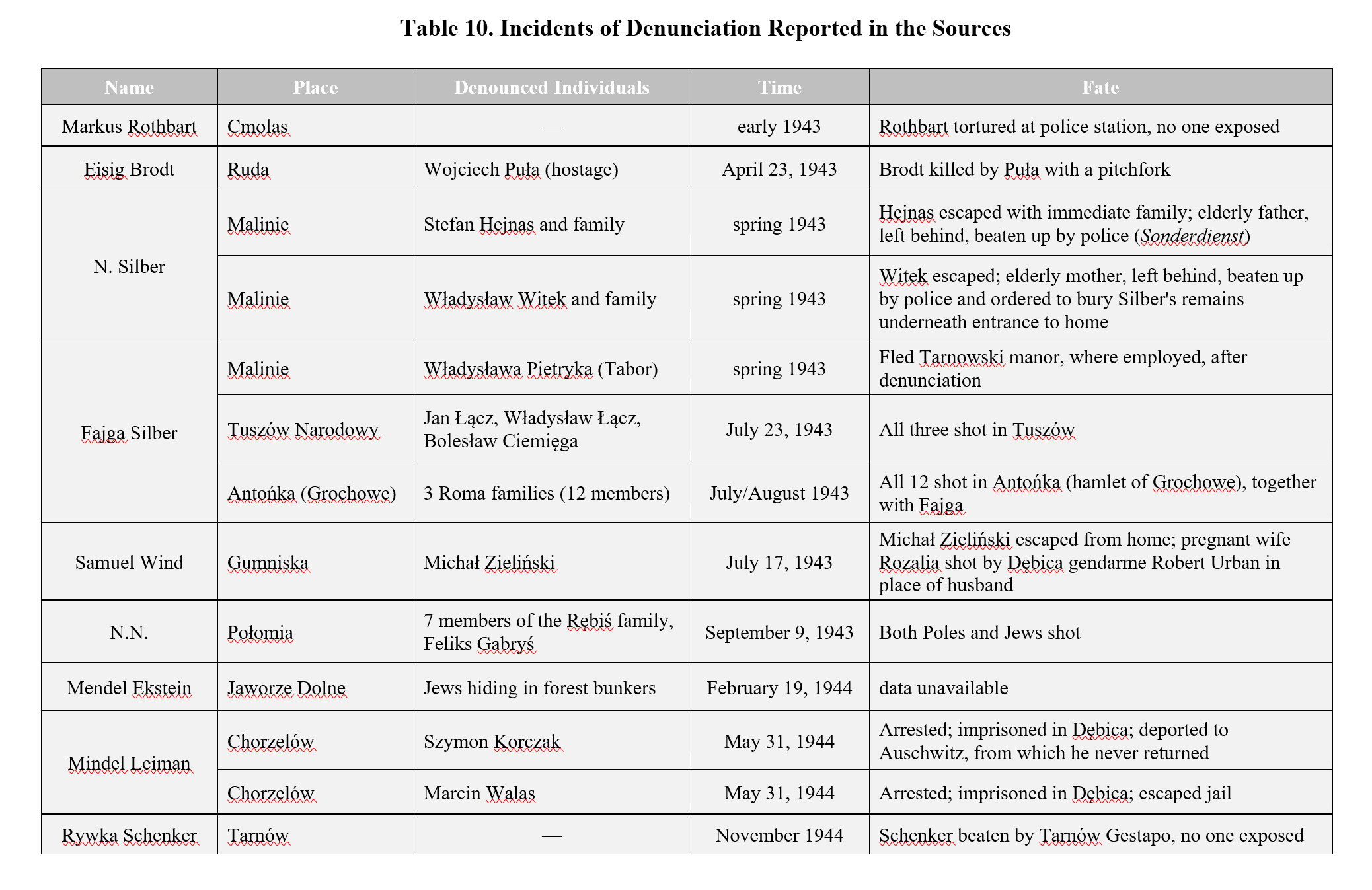
Likewise, the second section includes a table that documents ten cases of the capture of a total of 32-35 Jews by locals following the German pacification of the village of Podborze as punishment for sheltering the Siegfried family by their neighbors, the Dudeks: “Jews Captured after the Pacification of Podborze on April 23, 1943” (Frydel 474; Table 11, reproduced at the end). These developments are observed in two surrounding communes: Radomyśl Wielki and Wadowice Górne. The two subchapters suggest a causal link between both phenomena – the fears of the local population and the capture of Jews in the region – while the tables represent the factual basis for a detailed discussion found within those 22 pages. I write that the link between both was perceptual in nature, which led to a “perception of reality in which the fear of German repressions overlapped with the fear of the exposure of Poles by previously sheltered Jews” (Frydel 475). I found the motif prominent and important enough in the region to warrant a separate consideration, while reflecting on its impact on Jewish survival in the Polish countryside – the proper subject of the chapter. As far as I am aware, this is the only sustained treatment of the subject in scholarship on the Holocaust.
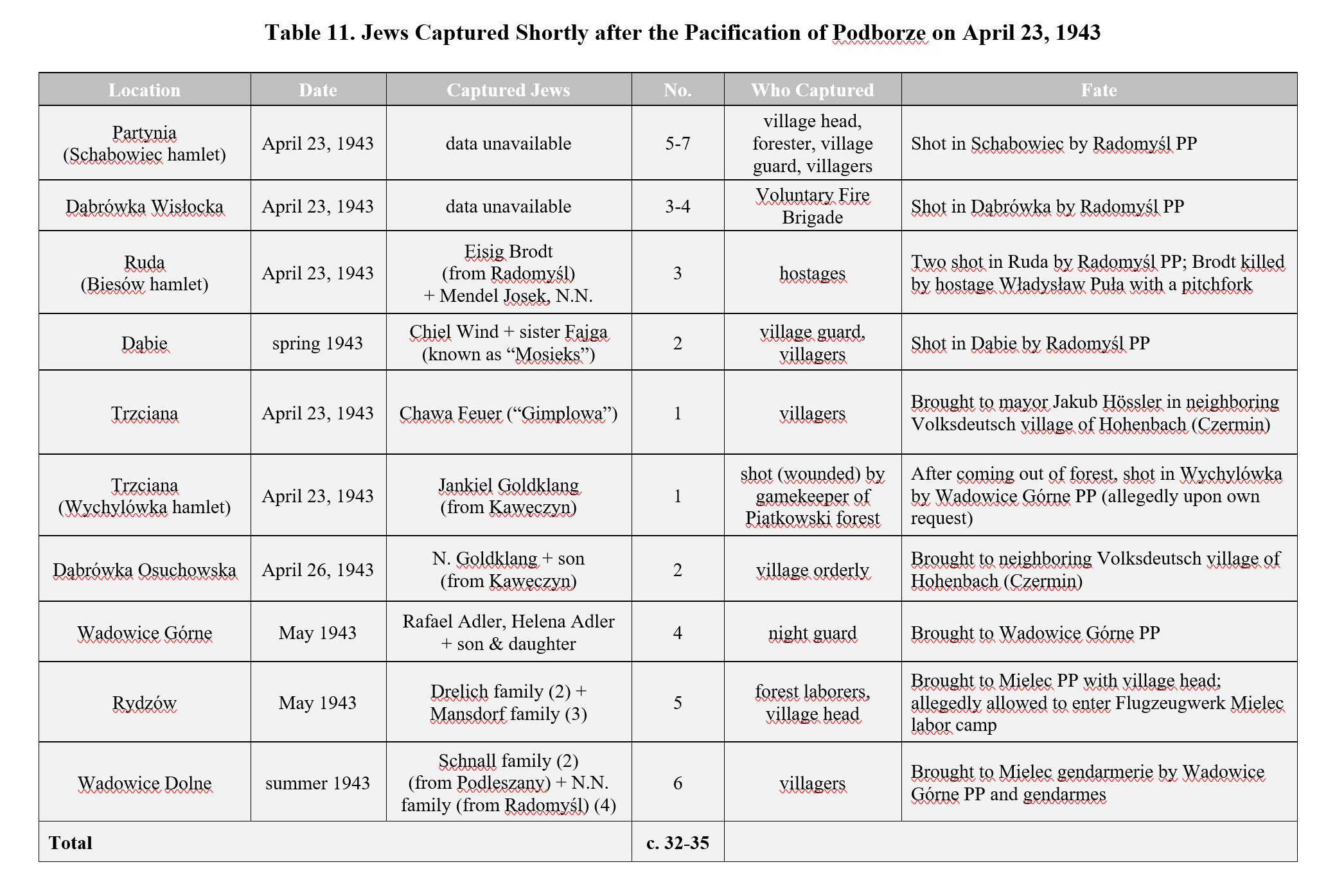
A few words of qualification by way of introduction. Needless to say, the aim here was not to set the historical stage for a “moral equivalence” between the “denunciation” of Jews by Poles and vice versa. Though both were targets of German policies and violence, the two groups found themselves in a fundamentally different position under occupation. Rather, my goal was to restore the social dynamic in its entirety, as the documents for the region provide a unique opportunity for its reconstruction. I also by no means claim that this “logic” born of the conditions of German occupation explains all manifestations of violence towards Jews on the local level. While microhistory does not permit generalizing its findings, the observed pattern or structure of communal violence has broader implications beyond the borders of Kreis Debica. As I noted: “What took place in Podborze should be treated as a particular manifestation of a wider social process that emerged around the hiding and denunciation of Jews in the Polish countryside” (Frydel 475). I also do not suggest that every instance of German repression for the shelter of Jews (or others) gave rise to such a dynamic or in the same force. The door remains open for other scholars interested in exploring the matter. But at least in contrast to other acts of German violence in the region, the “pacification of Podborze stood out in Kreis Debica for the greatest number of homes destroyed and the most clearly synonymous with punishment for the shelter of Jews” (Frydel 465).
Ranke and Social History: Two Ships Passing in the Night
The beginning of historical wisdom is often said to start with a recognition of the difference between perception and reality. Historical accuracy requires that we make every effort to separate Leopold von Ranke’s ‘Wie es eigentlich gewesen ist’ (‘the way it really was’) from ‘Wie es scheinbar gewesen ist’ or how it seemed or appeared to people at the time. Causality requires seeing how perceptions (and misperceptions) had a direct influence on shaping the reality on the ground. The question of everyday or social life rests (like all historiography) on empirical evidence, including evidence about states of mind as well as external facts. In the context of German terror in the Polish countryside, this calls for shedding some light on the fears – real or imagined – that locals projected onto fugitive Jews and that animated their behavior.
The reviewer turns his attention to my discussion of the relationship between the fear of denunciation and local violence directed at Jews (Domański 39-40). However, his characterization is a fundamental mischaracterization of what I wrote in this regard. He fixates on the word “imagined” in my discussion of the social mechanisms and social dynamics surrounding these events, claiming that I deny the reality of such denunciations and that I negate them as a figment of local farmers’ imagination as a sort of “phantasmagoria” (39). But how could such a criticism stand in light of my lengthy reconstruction of these events, shown above?
Dr. Domański's fundamental fallacy is that he takes “real or imagined” to mean “imaginary”. For example, he writes: “Frydel’s description of them [cases of denunciation] does not change anything in the matter, because there were also situations in which the formerly sheltered became the informer. And it is difficult to see how the threat of denunciation on the part of those previously sheltered was imagined” (39). The reviewer’s confusion of categories is confirmed by a subsequent observation: “Yet the author himself quotes on the next page facts showing that the threat was real and not imagined. He lists cases when Jews were forced to denounce their hosts” (40). And so the reviewer goes on like this in a circle of his own making.
Let me remind the reader of the methodology of microhistory used in the chapter, employed by all contributors and laid out in the introduction by the editors (Night Without End, Vol. 1, 16-19, “Methodological Questions”). Microhistory overlaps with other approaches of social history, such as the history of the “everyday” (Alltagsgeschichte) and “bottom-up” history, which seem particularly appropriate given the subject under investigation – namely, the struggle of individual Jews to evade the German machinery of death in rural Poland.
Throughout my chapter, I place particular emphasis on the dimension of social history in reconstructing the tragic struggle for life and death in the small administrative unit of German Lebensraum that was Kreis Debica. The specific circumstances of the county led me to divide Jewish survival strategies into ‘microgeographies’ of the village, the forest, and the camp – a basic methodological fact that goes unmentioned by the reviewer. As I wrote at the outset in a section entitled “Methodology”: “Each of the three strategies were shaped by a configurations of relations and it would be appropriate to treat each as a separate social habitus” (Frydel 368-369). In the concluding section, I note: “The numbers alone do not capture the complex reality of Jewish survival strategies. Equally important – especially in a microhistory as a discipline of social history – especially in a microhistory as a discipline of social history – An equally important dimension of this history – especially in a microhistory as a discipline of social history – are the mechanisms and social processes that shaped the behavior of both the Jews and their Polish surroundings” (Frydel 519).
And so it is in the section under discussion. At the very outset of the section, I write: “In order to understand the events under analysis, of fundamental significance is not only a reconstruction and corroboration of the facts but an analysis of the ideas and perception that informed human behavior. [...] As the sources confirm, in a few cases such fears were justified, but the fear of denunciation played a much larger role in the social imaginary of the occupation. It had an impact on the course of violence in the countryside” (Frydel 456). The brutal conditions of the German occupation caused profound social transformations, which led different groups to see each other differently. Part of my interest was in the change in perception under forms of extreme violence: “As German repressions increased from 1942, powerful links – real and imagined – began to form between fear of collective punishment of the village collective and the presence of Jews” (476-477). Other scholars of interethnic violence beyond the Polish context such as Max Bergholz – a historian I cite in the relevant section (Frydel 475, fn. 317) – have emphasized the importance of extreme violence as a “generative force” in dramatically transforming social relations (Max Bergholz, Violence as a Generative Force: Identity, Nationalism, and Memory in a Balkan Community (Ithaca: Cornell University Press, 2016)).
All of this appears to have been lost on the reviewer, who in one place appears to express a preference for a Rankean historiography of empirical facts when dealing with communal violence, while in another place he criticizes the book for not dealing sufficiently with “the question of the everyday or social life of Jews in the 1939-1942 period” (25). Even a review dealing primarily with sources has some obligation to consider the historiography that informs a given work, especially for a reviewer who repeatedly evokes the integrity of the historical profession. Still, all of the above could perhaps be forgiven as a matter of two historiographical ships passing in the night.
Methodology & Sources
However, the reviewer keeps digging. Here we start to see claims bordering on bad faith. For example, before getting into the details of my discussion, I made a brief note in the first paragraph about the potential for an interpretive trap when dealing with this specific issue:
It should be noted that the issue faces an interpretative challenge, as emphasizing the danger of exposure by Jews could have been used as a simple defense strategy of the accused in postwar trials. An uncritical acceptance of an alibi as a historical fact runs the risk of reproducing a narrative that “blames the victim” in the historical reconstruction. The historian must therefore proceed with caution. (Frydel 456)
Domański takes the sentence in bold to mean that I’m dismissive of peasant fears. “It lacks seriousness to disregard this problem in statements such as: ‘emphasizing the danger of exposure by Jews could have been used as a simple defense strategy of the accused in postwar trials,’” he writes (39). Nothing can be further from the truth. The section under discussion (as is the whole chapter) is an application of the basic hermeneutic of historical empathy towards all actors – Jews and Poles alike – caught in the hellish dynamics of the German occupation. As the reader can see, the reviewer’s framing is something of a manipulation. The quoted sentence was part of a brief preamble on sources and interpretive issues related to the postwar trials in terms of this particular phenomenon. It is not a dismissal, but a methodological word of warning. Accused former members of the Blue Police (Polnische Polizei) often justified their actions in this way, which is all the more reason to approach the claim critically. Taken out of context by the reviewer, the sentence takes on a different meaning.
Yet in another place the reviewer claims that sensitivity to the source material, particularly the August Decree trial records (sierpniówki), is missing from Night Without End. “It should be noted that this source is as important as it is unique, because it was created under the specific conditions of an investigative apparatus and a ‘justice system’ of a totalitarian regime. These files require particular attention and verification, which the authors often avoid,” he writes (29), reminding readers that “It should have been necessary to ask whether problems of an interpretive nature were encountered in the analyzed sources – after all, this is the foundation of the historian’s craft. [...] It is a conditio sine qua non of introducing the reader to the source base.” (28). I agree with the reviewer about the importance and the challenge of working with this specific body of postwar trials. All evidence has to be treated critically. It was precisely in this spirit that I raised the issue (an interpretive claim), however briefly, though the reviewer nonetheless mistook the sentence as a way of dismissing or minimizing the fears of local Poles (a normative claim).
Another note on sources. The reviewer states: “an analysis of the source base actually used in the ‘county’ descriptions shows that the dominant sources are various kinds of testimonies and memoirs of survivors (rarely the legacy of Polish memoir literature)” (28). This is one of the many sweeping generalizations found in “Correcting the Picture” without sufficient sensitivity to individual chapters. Speaking for Kreis Debica, again, the guiding principle of division was determined by the “microgeographies” of the village, the forest, and the camp, which in turn largely dictated the choice of sources. In some places, the historian can rely on the only sources available, as in my reconstruction of Jewish survival in the Dulecki forest (a third of the chapter entirely ignored by the reviewer), which would be impossible without Jewish memoirs and oral testimonies. We have to work with whatever evidence the past has bequeathed us and make the best of it. In terms of the subject under discussion, it is simply not true that the dominant sources used here are testimonies and memoirs of Jewish survivors. In fact, the main sources are “Polish” testimonies drawn from the August Decrees, Home Army reports, the findings of the Main Commission for the Investigation of Hitlerite Crimes in Poland and Polish diarists, chroniclers and memoirists, including the following:
- Antoni Balaryn of Radomyśl Wielki: Martyrologia ludności żydowskiej z Radomyśla Wielkiego i okolic podczas II wojny światowej (1989)
- Polish testimonies gathered by Maria Przybyszewska near Podborze: “Bez grzechu zaniechania”. O martyrologii mieszkańców Podborza – 1943 (2007)
- Antoni Darłak of Dębica: Stanisław Darłak i jego Dębica. Wspomnienia z życia wychowawcy wielu pokoleń, nauczyciela muzyki, kombatanta i społecznika, w setną rocznicę jego urodzin (1998)
- Testimony of Stefan Janusz of Pilzno: AŻIH, 302/202 (c. 1949)
- Testimony of Rev. Dr. Jan Terlaga of Podleszany: AŻIH, 301/217 (1945)
- Diary of Anna Węgrzyn of Mokre in: Tomasz Czapla, Pamiętnik z Mokrego. Wiejskie obrazy minionego wieku (2014)
- Testimony of Józef Mądry of Chorzelów (1980) from the private archives of Stanisław Wanatowicz in Mielec
- Accounts gathered by Adam Musiał in: Krwawe upiory. Dzieje powiatu Dąbrowa Tarnowska w okresie okupacji hitlerowskiej (1993)
- Franciszek Kotula, Losy Żydów rzeszowskich 1939–1944. Kronika tamtych dni (1999)
- Account of Władysława Pietryka (née Tabor) held in the Centrum Pamięci Generała Władysława E. Sikorskiego – Gminna Biblioteka Publiczna w Tuszowie Narodowym
- Interviews carried out by the author in the vicinity of Podborze in 2015, among them Agnieszka Pieróg (née Dudek) involved in the shelter of the Siegfried family in question (Night Without End, Vol. 2, 667-668, bibliography).
In fact, it is “Jewish” testimonies that form a minority of voices when examining this issue. At the same time, it must be emphasized that these proportions are not the result of a deliberate selection of sources, but from the desire to utilize all of the available materials that I was able to discover. I invite the reviewer to reacquaint himself with the footnotes. As with many claims made by the reviewer, the broad generalizations do not hold up under scrutiny.
Déjà Vu – or Gontarczyk Good, Frydel Bad
There is some irony in the fact that the dynamics under discussion appear to be similar to those described by the reviewer in relation to the villages of Wolica and Wierzbica (Kreis Miechow), cited with approval when referencing an article by Piotr Gontarczyk (38, Piotr Gontarczyk, “Śmierć Jankiela Libermana, czyli o pewnej antycznej tragedii na polskiej prowincji w czasie II wojny światowej” [The Death of Jankiel Liberman, or Concerning an Ancient Tragedy in the Polish Countryside during the Second World War], Sieci 46 (2018): 100-103), but dismissed in relation to my own work, even as the publication of Night Without End preceded the latter and the mechanisms in question were described in far greater depth and scope. Domański writes: “A serious regard for the historical matter and the readers would in this case require showing the broader context surrounding the event. This concerns the German actions that preceded the crime. They show a hellish entanglement that produced a combination of German terror, the execution of criminal regulations and a fear that engulfed entire communities, which were helpless against the violence of the occupation,” adding that “a researcher into such a story should perceive the mechanism that generated a widespread German terror against the Poles” (39). A “hellish entanglement” indeed! The fair-minded reader will recognize that this precisely what my two subchapters were about. The reviewer merely ventriloquizes the findings in slightly different form, seemingly unaware that he’s pushing through an open door.
I have written about this very “hellish entanglement” in previous publications, among others, in an unambiguously titled article, “The Pazifizierungsaktion as a Catalyst of Anti‑Jewish Violence: A Study in the Social Dynamics of Fear,” published in 2016 in an edited volume not by accident organized around the theme of “Social Processes and Dynamics” of the Holocaust and referenced in the chapter (Frydel 466, fn. 290), had the reviewer taken better stock of this fact. I have consistently drawn attention to this phenomenon in other articles and reviews (see selected publications at the end). Curiously, the matter never raised any confusion and was always understood in its intended meaning.
The reviewer notes that Night Without End “generally lacks an in-depth reflection” about the all-pervasive impact of the death penalty, the principle of collective responsibility weighing on the population, and the specific roles imposed on members of village collectives under occupation, though I receive some credit in passing for touching on this fact (16). He could also have continued to cite my observation that “It was the institutional role that largely determined the range of behavior and it is no accident that the vast majority of individuals tried after the war for collaboration were not a random sample of peasants, but those who were accused on the basis of their position in this security system” (Frydel 446-447). In fact, my discussion around the violent dynamics surrounding German repressions is precisely an attempt at such an “in-depth reflection” of the way the toxic atmosphere of fear of collective responsibility was mobilized and in which the leading role was played by individuals tasked by the Germans with such responsibilities (the village heads, village guards, hostages, foresters, gamekeepers, and the like), though I frame this in terms perhaps less familiar to the reviewer.
Nitpicking as Scholarly Critique: The Testimonies of Berl Sturm and Leopold Trejbicz
In terms of source criticism related to Kreis Debica, the reviewer points to my use of two testimonies – that of Berl Sturm of Dębica and Leopold Trejbicz of Pilzno (Archives of the Jewish Historical Institute in Warsaw (AŻIH), file 301/4596, account of Berl Sturm, undated, typescript, 1-4; AŻIH, 301/4596, account of Leopold Trejbicz, August 26, 1957, typescript, 1-16). This is presumably meant to align with the broader charge applied collectively to the “authors” of removing fragments from testimonies and of manipulating the sources. I mentioned the case of Berl Sturm in the following context:
A number of incidents are reported in the county, in which Polish shelterers were guided by the perception of exposure by Jews. When Berl Sturm and other Jews from the Dębica ghetto were captured in the forest of Łęki Dolne, where they were helped by the Job family, “the entire family of Stefania Job escaped in fear that we would betray them for hiding us.” After escaping the Dębica ghetto, Perel Faust and her husband were taken in by a Polish family. When a German policeman moved into the room next door, the Jews were immediately told to leave, but the granddaughter exclaimed: “Grandmother, if they leave, they will shoot us, for they will certainly reveal that they were with us!” Faust added, “They did not want to keep us anymore, but they could not let us go, for then they would be in danger. Indeed, they were in great danger.” In the hamlet of Biesów (village of Ruda), Eisig Brodt was sheltered by a hostage, Wojciech Puła. When Brodt was captured in the course of a search and allegedly admitted to his captors that he was sheltered by Puła, the latter killed Brodt on the spot, supposedly to prevent further consequences to himself as a hostage. The previously mentioned Dubiel, the “protector” of the Ladner family in the vicinity of Siedliszczany, he distributed the mother and two daughters in different farms with a similar thought in mind: “Dubiel did not tell me where my daughters were located. He did it so that if one fell into the hands of the Germans, she would not be able to betray the other.” This awareness prompted Jewish families to hide in smaller groups or individually. Fewer people would fall victim to arrest, and peasants could be more willing to help one fugitive rather than a whole family. (Frydel 456-457)
I cite the entire paragraph to demonstrate the reviewer’s repeated method of mining the text to find issue with trivial matters, which gives the impression of “disproving” an important thesis. The above paragraph touches on four cases in which Poles, with good reason, projected fears of potential exposure onto the Jews they sheltered or encountered in the event of capture. The reviewer takes issue with the highlighted sentence above. He writes:
As an example of the “imaginary threat of denunciation,” Frydel used the dubious example of the Job family, whose members had helped the family of Berl Sturm for a lengthy period of time. Toward the end of the occupation, the Jews were arrested by the German police. If we keep with the literal words of Sturm’s account, it should be written that it was not the entire family escaped at the news of the Sturms’ arrest, because the person most involved in rescuing the Jews, Stefania Job, remained “at her post.” In addition, the Jobs repeatedly faced dramatic choices in order not to cause the discovery of the Jewish family. The brother and father of S. Job volunteered for forced labor in place of Stefania. Earlier, she was even temporarily arrested and was even shot at. Interestingly, the Germans who arrested the Jews themselves showed disobedience to criminal regulations. They fed them and let them continue hiding with the Poles. But it was an exception that was hard to anticipate. If the Jobs knew about this, would they decide to escape? (39-40, fn. 84)
I’m struggling to understand the reviewer’s logic here, how it furthers along the discussion, or undermines anything that I wrote. Presumably Domański thinks that I should have included more of the details found in the testimony. Given the obvious limitations of space, an author must discipline his discussion with the most relevant excerpts to keep with the flow of the narrative. It is true that technically the “entire” family did not escape, as noted by the subsequent sentence in the testimony that I did not cite: “Only Stefania Job remained, faithful at her post.” But does this fundamentally take away from the relevant point about how powerfully such fears could galvanize a family? (I will skip the purely linguistic issue: the expression that “someone’s family left” does not necessarily imply the departure of that someone with their family). To the reviewer’s question, had the Jobs known that they would encounter a group of kind German policemen, would they still escape? Well, I suppose not. But why speculate on what any historian of the German occupation would recognize as the rare exception (Befehl-breaking German policemen) rather than the rule – a widespread fear that in this case compelled “all family members but one” to run away? (Interestingly, the reviewer has inadvertently shifted to speculating about “imagined” outcomes). If I wanted to cite additional excerpts of Berl Sturm’s testimony to support my point, I might have chosen the remaining lines from the same paragraph:
At the request of the Ortskommandant, where we stayed till now, we stated that we were hidden by a Polish acquaintance in Mielec (where at that time the Russians were already present). Fortunately, they believed us. They asked where we got the food from, I replied that in the fall I had dug potatoes and carps and that we lived on these the whole time. (AŻIH, 301/4596, account of Berl Sturm, 4)
What might have happened to the Jobs had Berl Sturm and his daughter not lied to the Germans about who fed and protected them for almost two years? How the reference to the Job family in the context under discussion is a “dubious example” remains to be demonstrated by the reviewer.
Domański approaches my use of the testimony of Leopold Trejbicz in the same spirit. I draw on the testimony in two places. First, as a source of information that the Pilzno ghetto was surrounded by barbed wire and guarded by the Ordnungsdienst on the inside and the Blue Police on the outside (Frydel 393). Second, as a source on the atmosphere in the Dębica ghetto following the first Aktion (after the Jews of Pilzno were resettled there), which I cite directly from the testimony: “The only subject of discussion and the driving force behind the actions of the handful of remaining Jews was how to save themselves, get out of the ghetto and escape destruction” (Frydel 422). Two different contexts. Domański brings the issue up in yet another context of his discussion of Jewish denunciation:
Awareness of the threat of denunciation on the part of other hiding Jews is found in the account of Leopold Trejbicz. Hiding on “Aryan papers” in Warsaw, he did not reveal his address to another Jew, Marcel Fleiszer, hiding in the same way and passing as Bogdan Czerwiński. “We decided,” wrote Trejbicz, “for reasons of security, not to share our addresses or meet outside the factory.” Such is the nature of conspiracy – every person can be a potential threat, because we do not know who’s who and one’s endurance in the event of falling into the hands of the enemy. And nationality has nothing to do with this. Drawing on the memories of Trejbicz, however, Frydel did not use this excerpt. (40)
Domański uses this case to make two points (in bold). First, that the all-pervasiveness of denunciation under German occupation was irrelevant to the question of nationality, as Jews could also denounce other Jews. Second, the reviewer seems to make the under-handed suggestion that, by not citing this part of Trejbicz’s testimony, I’m playing ‘hide the ball’ with this fact. But I already mention such a possibility within the county: “While in Nowa Wieś on the territory of Army Base “South” [Truppenübungsplatz Süd], Mejlech Notowicz recalled after the war that among the 200 Jews from nearby camps who were shot, “14 Jews [were] from Rzeszów, on Aryan papers, denounced by some Jew” (Frydel 462). I also note in a similar case outside of the county in the Subcarpathian region: “Not far from Dębica county, the Leichter family – escaped from the Łańcut ghetto – adopted the following strategy: ‘The father also learned that the captured Jew Izak ... [sic], under the influence of a beating and the promise that his life would be spared, revealed a hiding place from which the Germans pulled out and shot a few Jews. He too did not save his own life, because in the end the Germans also shot this Jew as well as his wife and children. That’s why my father decided that each of us should go in a different direction’” (Frydel 457, fn. 266). So why should I make a reach for the admittedly weak example mentioned by Domański? What new insight would it bring to the analysis?
Given the fact that I already mention this above and the fact that I dedicate 13 pages to the case of Jewish informers in the Bäumer und Lösch camp near Mielec (Frydel 499-511) –abundantly acknowledged and appreciated by the reviewer in another place (62-65) – I’m not convinced that a lesson about the irrelevance of nationality to the question of denunciation was needed here, as the issue is quite transparent. I don’t continue dwelling on the story of Leopold Trejbicz and his sister Bronisława after their relocation to Warsaw for the simple reason that the focus of the study is Kreis Debica. Given the limitations of space, if relevant non-Dębica examples are to be used on the margins, those from the Subcarpathian region are the most appropriate.
The Case of Straszęcin: German Provocations and Repressions
Domański returns to the matter of pacification actions in another place (64) to take issue with a single sentence in which I point out in passing to analogous dynamics in relation to non-Jewish groups targeted by the Germans: “Similar fears and situations that followed in the aftermath of acts of repression can also be observed in relation to other groups in hiding, i.e., fugitive prisoners of war” (Frydel 476). In the footnote, I use the following example to demonstrate the point:
In the village of Straszęcin, the village head, together with the night guards, captured two Dutch prisoners of war, who had escaped from Pustków [concentration camp], and transferred them in chains to the Blue Police in Dębica. Both men were previously hidden in the village, but after the pacification of the nearby village of Bobrowa on July 8, 1943, the inhabitants now looked at the matter in a different light. (Frydel 476, fn. 323)
Domański writes the following:
The events of the fall of 1943 in the village of Straszęcin described by Frydel (vol. 2, p. 476) supposedly provoked panic among the inhabitants of the village in Dębica county following pacification actions, as a result of which they captured individuals pursued by the Germans. Selected as an additional illustration of this thesis, the example (the case of Jan Skowron) not only does not confirm it, as the author suggests, but quite simply denies it. The capture of two persons, presumably of Dutch nationality, involved several factors, among which of decisive importance were the many doubts the inhabitants had about the origin and behavior (intent) of these fugitives. In the village, they were even accused of spying for the Germans and intelligence operations. It was also pointed out that the pacification of the nearby village of Bobrowa took place after the appearance of peddlers of devotional items. The use of provocation methods to combat the underground as well as to terrorize and intimidate civilians was widely disseminated by German authorities in the occupied territories. (64, fn. 181)
Domański is correct to note that the case in question included additional variables, such as the suspicion that the two men of Dutch nationality were informers working for the German police. In fact, the court ultimately accepted this version of events in its final verdict and all of the accused were found innocent (Archives of the Institute of National Remembrance in Rzeszów (AIPN Rz), file 358/59, Trial of Jan Skowron and others, judgment of the Voivodship Court in Rzeszów during an offsite session in Dębica, September 26, 1951, 320-326, here 323-324). I should have noted this factor. However, there was initially uncertainty about the identity of the men and this storyline emerged later in the trial. For example, at the outset, Stanisław Kolbusz, the commandant of the village guard in the hamlet of Wola Bobrowska (village of Bobrowa), was told that the two men “escaped from the camp in Pustków,” which was about 1 km from the hamlet.( Ibid., interrogation of witness Stanisław Kolbusz, Wola Bobrowska, December 30, 1950, 15) Likewise, Jan Skowron, the deputy village head, spoke of “some two Dutchmen, who probably escaped from the camp.” (Ibid., interrogation of the accused Jan Skowron, Wałcz, March 3, 1951, 23) Others confirmed this impression. (Piotr Golemo, who was ordered by Skowron to hand over his horse and deliver the men to the police as punishment for sheltering the men, stated: “two young Dutchmen, escaped from the camp in Pustków, were hiding on my property. The Dutchmen stayed on my field and at night they escaped into the bushes,” ibid., interrogation of Piotr Golemo, Dębica, April 28, 1951, 51) A Soviet prisoner of war was also reported to have been sheltered by Kolbusz and his family.( Ibid., statement of evidence by the accused, Dębica, August 14, 1951, 199) There was indeed confusion about the identity of the men until the narrative began to crystalize around the notion of informers, and the court did not, in the final analysis, corroborate the claim that the Dutchmen were fleeing German persecution. This is precisely the place where analytical care is needed in approaching the August Decree trial material, cautioned previously by Domański, but now ignored.
Nonetheless, the existence of additional variables does not deny the link that I sought to demonstrate. Despite the confusion around the identity of the men, it was the pacification of Bobrowa in the summer of 1943 that many witnesses described as a major and the most immediate catalyst for the capture of the men. The court itself acknowledged the event in its verdict: “Sometime in the summer of 1943, a pacification took place in the neighboring village of Bobrowa, in which some 20 people fell victim by shooting.” (Ibid., judgment of the Voivodship Court in Rzeszów, Dębica, September 26, 1951, 322) Further, we do not have to rely on the verdict on the court to note the impact the event had among the accused and witnesses. There is also no reason why both factors could not coexist. For example, the wife of one of the accused testified: “Immediately prior to their capture, a pacification took place in the neighboring village of Bobrów, where 23 people were killed, as a result of which the residents of Wola Bobrowska lived in constant fear, apprehensive of [any] hostile elements found on the territory of the village.” (Ibid., statement of the wife of suspect Stanisław Kolbusz, Stefania Kolbusz, Dębica, June 6, 1951, 78) The village head of Bobrowa also submitted a statement in which he noted:
In 1943, a terrible pacification was carried out by the Germans in Bobrowa, in which 21 people were shot and two homesteads burned down, so that from this time the people of the entire village lived in perpetual fear, and at this time unknown people – regarded as Dutchmen in the service of the Germans, who at the same time were involved in selling – were loitering, which gave rise to suspicion and fear among the local population. (Ibid., affidavit of the village head of Bobrowa, Straszęcin commune, Żyraków, November 15, 1951, 285)
The accused Stanisław Kolbusz evoked the Bobrowa pacification action in the following way:
Sometime in the summer of 1943, already after the pacification in Bobrowa, Skowron came to my house and told me to come with him to capture those people who were dangerous to the village – some sort of spies, who people said were Dutchmen. I said that maybe we could get by without doing this, but he replied that they were dangerous, that things could end badly, just like they did in Bobrowa. In Bobrowa, a stranger allegedly spent the night in the home of Mordyńska, and then the Germans shot several people in her home and others and burned down two homes. (Ibid., main hearing, deposition of Stanisław Kolbusz, Dębica, September 25, 1951, 294)
Another of the accused, Ludwik Adamowicz, testified:
In the summer of 1943, returning from Wisłoka, it was still light out, I was called by Skowron and Kolbusz standing near the house of [Andrzej] Wójko and the road, who told me there were German spies in his home. Skowron gave me a chain and told me to go and tie them up. I said that perhaps they were Poles, Jews or Russians, who were hiding from the Germans, then Skowron replied that here I am shunning going over to tie them up, while they could be spies who are spying on me and that because of me half the village could be shot, just like they were shot in Bobrowa. Then I took the chain and went over to the home of the Wójkos. (Ibid., main hearing, deposition of Ludwik Adamowicz, Dębica, September 25, 1951, 296)
For an “illustration” of a thesis that, according to the reviewer, “does not confirm,” but “quite simply denies it,” this is quite a number of references in the trial material to the contrary. And more of similar references can be found in the trial proceedings. Thus, the Bobrowa pacification and its associations among locals appear to have functioned as the most immediate “cause” of locals not taking any chances and handing them over to the police for fear of a similar fate, whoever the men were in reality. The fact that the Dutch men may have been informers operating in the capacity of a provocation action does not undermine the cause-and-effect relationship. Interestingly, the reviewer appears to lose interest in his own previous point about the irrelevance of nationality to acts of denunciation or violence in this context.
An additional word about “provocation actions.” Elsewhere, the reviewer writes:
the German police undertook measures of a provocative character, sending various spies into the region, and even organized armed groups impersonating the Polish underground. These challenges to the effective functioning of communities, which fugitives came into contact with, remain surprisingly outside of the authors’ sphere of interests. [...] they [the authors] sometimes consciously omit these issues despite their use of sources containing such descriptions. (19)
This is indeed an important factor, but why must the reviewer carry out one of many prosaic lectures about the nature of the German occupation when this aspect was already given exposure in the chapter on Kreis Debica, contrary to the claim that throughout the volumes “the reader will learn nothing about punitive [police] expeditions, the pacification of villages, and executions of peasants, etc. taking place at the same time and in the same territories [as the struggle of Jews to survive]” (18). At this point, I will resort to copying and pasting such excerpts from my chapter. For example:
What is more, the attitude of the local population was also shaped by various types of German provocations in rural areas. The report of the local district of the Home Army in the fall of 1943 contained a warning: “The Gestapo is releasing patrols dressed as bandits and the like, with old rifles on strings – armed besides with pistols – in order to provoke our hit squads. I recommend strict observation and caution when coming into contact with them, most of all in forests.” Such intelligence operations could be aimed at both underground organizations and local civilians, in order to test the latter’s obedience to German law as well as to spread fear and distrust of outsiders. For example, in the spring of 1943, the Kripo and gendarmerie of Dębica set up base in the village of Łączki Kucharskie (Ropczyce county), where they allegedly disguised themselves as partisans and made forays into surrounding villages, only to return the next day in the uniforms of the German police and punish locals for failure to inform the authorities about the presence of armed men passing through the village the previous day. (Frydel 419)
In another place, I write about the danger posed by provocation actions involving Jewish informers:
The presence of Jewish informers constituted yet another danger to be reckoned with by Jews hiding in the vicinity of Mielec and Polish villagers, who could never quite know who they were opening their doors to. The strategy of survival of [Jewish] collaborators in the camp, therefore, came into competition with the strategies of Jewish fugitives in the Mielec region, undermining the latter’s attempts and contributing to a general atmosphere of mistrust in the countryside. (Frydel 509)
Domański’s criticism is thus contradicted by the above excerpts and other parts of the chapter. If it needs to be said, an author can only give limited space to such phenomena that shaped the context of the proper object of investigation in the chapter – the struggle for Jewish survival.
A Correction of “Correcting the Picture”
The reviewer catches two factual errors in my chapter. One of these is mistaking the date of marriage between Stanisław Silberman (Kocoń) and Aleksandra Bryk for 1943 instead of 1945, as well as suggesting that the former had converted to Christianity (47). Another is accidentally transposing the names of the Selbstschutz with the Sonderdienst in describing German police forces in the county as well as a slip of a date from 1940 to what should have been 1939 (69). I am grateful to the reviewer for catching these, which is part of the proper function of the review process. Subsequent editions will be adjusted accordingly. However, the reviewer assigns to these an unusual level of significance. In terms of the first, he states: “Creations of this kind on the part of the author undermine, not for the first time, the credibility of his other statements, allegedly based on documents” (47). In the second case, he capitalizes on the error even more by stating that such “serious factual errors [...] are probably the result of an insufficient bibliographical query,” something allegedly symptomatic of the work as a whole (69). These are quite uncharitable claims.
Yet – in the same spirit – in correcting the first error Domański introduces his own. First, in a supporting footnote, he cites p. 520 as the page numer of the testimony of Aleksandra Kocoń (née Bryk), which bears the correct date of the marriage (47, fn. 116). But Aleksandra Kocoń’s testimony is to be found on p. 519; Stanisław Kocoń’s is on p. 520. (AIPN Rz, 353/72, Trial of Jan Skiba and Józef Bryk, deposition of Aleksandra Kocoń, main hearing, Rzeszów, June 7, 1950, 519; deposition of Stanisław Kocoń, main hearing, Rzeszów, June 7, 1950, 520)
Second, in summarizing my discussion of the Bäumer und Lösch camp, Domański mentions its first Jewish commandant “Frajberg,” noting in a footnote: “Perhaps someone by the name of Freiberg” (63, fn. 178). Had the reviewer paid better attention, he would have noticed that the matter had already been explained previously in the chapter: “In the postwar testimony, the name ‘Freiberg’ sometimes appears as ‘Frieberg’ and ‘Frayberg.’ I have decided to use ‘Freiberg,’ confirmed in a list created by the municipal government [in 1940] (Frydel 404-405, fn. 110). The matter therefore does not just concern “someone by the name of Freiberg,” but Leon Freiberg, the son of Judenrat member Izak Freiberg – a not inconsequential fact in understanding the survival strategy of the Jewish elite of Mielec discussed in the chapter.
Third, the reviewer writes: “Among the authors of individual chapters, only Tomasz Frydel noticed, and on the margins of the main discussion (vol. 2, p. 548), that evasion or desertion from the Baudienst was punished with severe penalties, including the death penalty” (13-14). I cannot accept this compliment, as the correct author of the passage is Dagmara Swałtek-Niewińska in her chapter on Bochnia county.
I noticed such “creations” only in relation to references to my chapter. In truth, as every author who has ever published anything knows – and as Domański himself has demonstrated – minor errors and oversights of this nature are inevitable, especially in a microhistory of a German administrative unit that combined three prewar Polish counties. But it takes the milk of human unkindess to elevate them to the status of grave historical errors or to suggest that such minor shortcomings somehow undermine the core findings or arguments of my chapter.
To conclude, it’s hard to disagree with the reviewer’s characterization of the German occupation, but the criticism derived from it bears no relation to what I wrote in my chapter on Kreis Debica. The critique ¬can be reduced to two aspects. The first is a fundamental misunderstanding of a discussion of the social dynamics and mechanisms of extreme violence set in a communal context, signalling the absence of a broad historiographical register regarding the Holocaust. The second is that the rest of the critique comes down to the inflation of largely inconsequential errors posing as substantive criticism. Menacing allusions to a manipulation of sources and the like are shown to be minor oversights upon examination. In alleging to demonstrate an a priori thesis in Night Without End, the reviewer appears to be laboring under his own a priori agenda to find fault with a given work. The liberal use of “authors” in reference to almost 1,700 pages of text, of which 160 was written by one author, allows the critic to paint with too broad a brush. Unfortunately, such “leveling” of an edited volume not only flattens the specific arguments and approaches taken by individual authors but betrays a remarkable indifference toward the important subject under investigation.
Selected Publications
Frydel, Tomasz. “The Pazifizierungsaktion as a Catalyst of Anti‑Jewish Violence: A Study in the Social Dynamics of Fear.” In The Holocaust and European Societies: Social Processes and Dynamics, edited by Andrea Löw and Frank Bajohr, 147-166. London: Palgrave Macmillan, 2016.
“The Devil in Microhistory: The ‘Hunt for Jews’ as a Social Process, 1942-1945.” In Microhistories of the Holocaust, edited by Claire Zalc and Tal Bruttmann, 171-189, here 175-184. New York: Berghahn Books, 2017.
“Judenjagd: Reassessing the Role of Ordinary Poles as Perpetrators in the Holocaust.” In Perpetrators and Perpetration of Mass Violence: Action, Motivations and Dynamics, edited by Timothy Williams and Susanne Buckley-Zistel, 187-203, here 197-199. Abingdon, OX: Routledge, 2018.
Review of Michał Kalisz and Elżbieta Rączy, Dzieje społeczności żydowskiej powiatu gorlickiego podczas okupacji hitlerowskiej 1939-1945, Zagłada Żydów. Studia i Materiały 13 (2017): 776-783, here 781.
“The Ongoing Challenge of Producing an Integrated Microhistory of the Holocaust in East Central Europe.” Review of Anatomy of a Genocide: The Life and Death of a Town Called Buczacz, by Omer Bartov. Journal of Genocide Research 20, no. 4 (2018): 624-631, here 629-630.
[1] Tomasz Domański, Korekta obrazu? Refleksje źródłoznawcze wokół książki Dalej jest noc. Losy Żydów w wybranych powiatach okupowanej Polski, https://ipn.gov.pl/pl/aktualnosci/65746,Korekta-obrazu-Refleksje-zrodloznawcze-wokol-ksiazki-Dalej-jest-noc-Losy-Zydow-w.html, access 14 March 2019. As the English translation of this brochure has not been published yet, the page numbers refer to its Polish edition, with the quotations translated by the translator of this review. (translator’s footnote)



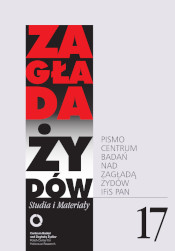

.jpg)
.jpg)


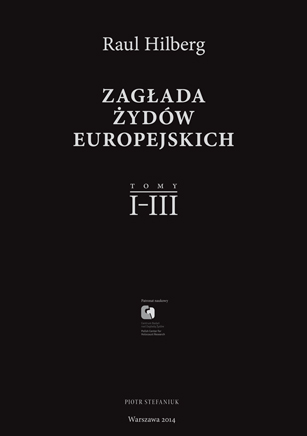
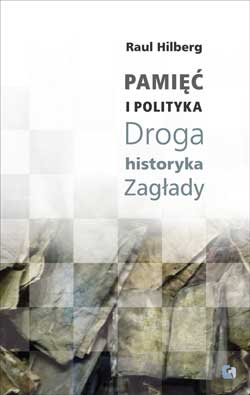
.jpg)
.jpg)
.jpg)
.jpg)
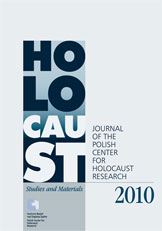

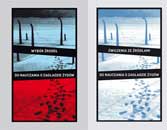
.jpg)
.jpg)
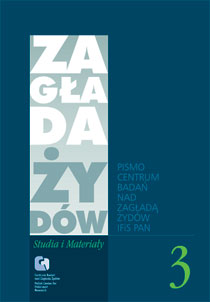
.jpg)
